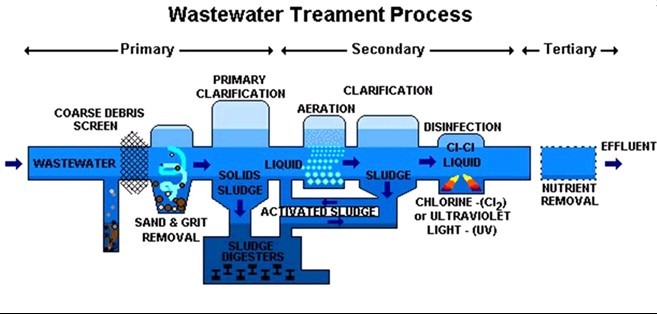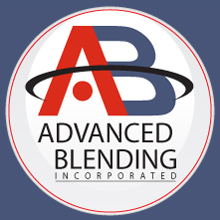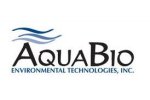Wastewater Treatment
Wastewater is used water. It includes substances such as human waste, food scraps, oils, soaps and chemicals. In homes, this includes water from sinks, showers, bathtubs, toilets, washing machines and dishwashers.
Effects of wastewater pollutants
If wastewater is not properly treated, then the environment and human health can be negatively impacted. These impacts can include harm to fish and wildlife populations, oxygen depletion, beach closures and other restrictions on recreational water use, restrictions on fish and shellfish harvesting and contamination of drinking water.
- decaying organic matter and debris can use up the dissolved oxygen in a lake so fish and other aquatic biota cannot survive;
- excessive nutrients, such as phosphorus and nitrogen (including ammonia), can cause eutrophication, or over-fertilization of receiving waters, which can be toxic to aquatic organisms, promote excessive plant growth, reduce available oxygen, harm spawning grounds, alter habitat and lead to a decline in certain species;
- chlorine compounds and inorganic chloramines can be toxic to aquatic invertebrates, algae and fish;
- bacteria, viruses and disease-causing pathogens can pollute beaches and contaminate shellfish populations, leading to restrictions on human recreation, drinking water consumption and shellfish consumption;
- metals, such as mercury, lead, cadmium, chromium and arsenic can have acute and chronic toxic effects on species.
- other substances such as some pharmaceutical and personal care products, primarily entering the environment in wastewater effluents, may also pose threats to human health, aquatic life and wildlife.
Wastewater treatment
"Primary treatment" removes about 60 percent of suspended solids from wastewater. This treatment also involves aerating (stirring up) the wastewater, to put oxygen back in. Secondary treatment removes more than 90 percent of suspended solids.
Sewage is the wastewater released by residences, businesses and industries in a community. It is 99.94 percent water, with only 0.06 percent of the wastewater dissolved and suspended solid material. The cloudiness of sewage is caused by suspended particles which in untreated sewage ranges from 100 to 350 mg/l. A measure of the strength of the wastewater is biochemical oxygen demand, or BOD5. The BOD5 measures the amount of oxygen microorganisms require in five days to break down sewage. Untreated sewage has a BOD5 ranging from 100 mg/l to 300 mg/l. Pathogens or disease-causing organisms are present in sewage. Coliform bacteria are used as an indicator of disease-causing organisms. Sewage also contains nutrients (such as ammonia and phosphorus), minerals, and metals. Ammonia can range from 12 to 50 mg/l and phosphorus can range from 6 to 20 mg/l in untreated sewage.
Sewage treatment is a multi-stage process to renovate wastewater before it reenters a body of water, is applied to the land or is reused. The goal is to reduce or remove organic matter, solids, nutrients, disease-causing organisms and other pollutants from wastewater. Each receiving body of water has limits to the amount of pollutants it can receive without degradation. Therefore, each sewage treatment plant must hold a permit listing the allowable levels of BOD5, suspended solids, coliform bacteria and other pollutants. The discharge permits are called NPDES permits which stands for the National Pollutant Discharge Elimination System.
Preliminary Treatment
Preliminary treatment to screen out, grind up, or separate debris is the first step in wastewater treatment. Sticks, rags, large food particles, sand, gravel, toys, etc., are removed at this stage to protect the pumping and other equipment in the treatment plant. Treatment equipment such as bar screens, comminutors (a large version of a garbage disposal), and grit chambers are used as the wastewater first enters a treatment plant. The collected debris is usually disposed of in a landfill.
Primary Treatment
Primary treatment is the second step in treatment and separates suspended solids and greases from wastewater. Waste-water is held in a quiet tank for several hours allowing the particles to settle to the bottom and the greases to float to the top. The solids drawn off the bottom and skimmed off the top receive further treatment as sludge. The clarified wastewater flows on to the next stage of wastewater treatment. Clarifiers and septic tanks are usually used to provide primary treatment.
Secondary Treatment
Secondary treatment is a biological treatment process to remove dissolved organic matter from wastewater. Sewage microorganisms are cultivated and added to the wastewater. The microorganisms absorb organic matter from sewage as their food supply. Three approaches are used to accomplish secondary treatment; fixed film, suspended film and lagoon systems.
Fixed Film Systems
Fixed film systems grow microorganisms on substrates such as rocks, sand or plastic. The wastewater is spread over the substrate, allowing the wastewater to flow past the film of microorganisms fixed to the substrate. As organic matter and nutrients are absorbed from the wastewater, the film of microorganisms grows and thickens. Trickling filters, rotating biological contactors, and sand filters are examples of fixed film systems.
Suspended Film Systems
Suspended film systems stir and suspend microorganisms in wastewater. As the microorganisms absorb organic matter and nutrients from the wastewater they grow in size and number. After the microorganisms have been suspended in the wastewater for several hours, they are settled out as a sludge. Some of the sludge is pumped back into the incoming wastewater to provide "seed" microorganisms. The remainder is wasted and sent on to a sludge treatment process. Activated sludge, extended aeration, oxidation ditch, and sequential batch reactor systems are all examples of suspended film systems.
Lagoon Systems
Lagoon systems are shallow basins which hold the waste-water for several months to allow for the natural degradation of sewage. These systems take advantage of natural aeration and microorganisms in the wastewater to renovate sewage.
Final Treatment
Final treatment focuses on removal of disease-causing organisms from wastewater. Treated wastewater can be disinfected by adding chlorine or by using ultraviolet light. High levels of chlorine may be harmful to aquatic life in receiving streams. Treatment systems often add a chlorine-neutralizing chemical to the treated wastewater before stream discharge.

Advanced Treatment
Advanced treatment is necessary in some treatment systems to remove nutrients from wastewater. Chemicals are sometimes added during the treatment process to help settle out or strip out phosphorus or nitrogen. Some examples of nutrient removal systems include coagulant addition for phosphorus removal and air stripping for ammonia removal.
Sludges
Sludges are generated through the sewage treatment process. Primary sludges, material that settles out during primary treatment, often have a strong odor and require treatment prior to disposal. Secondary sludges are the extra microorganisms from the biological treatment processes. The goals of sludge treatment are to stabilize the sludge and reduce odors, remove some of the water and reduce volume, decompose some of the organic matter and reduce volume, kill disease causing organisms and disinfect the sludge.
Untreated sludges are about 97 percent water. Settling the sludge and decanting off the separated liquid removes some of the water and reduces the sludge volume. Settling can result in a sludge with about 96 to 92 percent water. More water can be removed from sludge by using sand drying beds, vacuum filters, filter presses, and centrifuges resulting in sludges with between 80 to 50 percent water. This dried sludge is called a sludge cake. Aerobic and anaerobic digestion are used to decompose organic matter to reduce volume. Digestion also stabilizes the sludge to reduce odors. Caustic chemicals can be added to sludge or it may be heat treated to kill disease-causing organisms. Following treatment, liquid and cake sludges are usually spread on fields, returning organic matter and nutrients to the soil.





